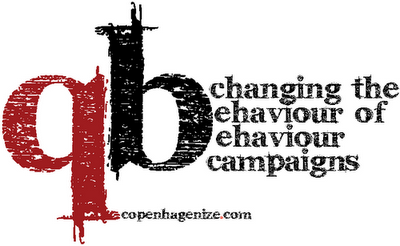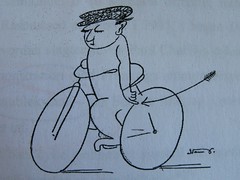

When I was invited to speak in New York recently, one of the lectures was about behaviour and the challenges of changing it. I figured I’d slap the lecture onto the blog. Behaviour is a tricky subject and getting groups of people to change their behaviour is never easy. Lately, behaviour is a hot topic in Emerging Bicycle Cultures. Many people who ride bicycles are generating bad press because of the way they’re cycling and many other cyclists are getting branded negatively by association. Generally, bad behaviour is a sign that cyclists don’t have adequate infrastructure. Increasing cycling’s infrastructure and profile is a good way to calm the traffic in more ways than one. We’re at an interesting point in the reestablishment of urban cycling as a norm. Bicycles have been a fad, a trend, for almost two years now. There is every indication that we are finally returning to a place where the bicycle is regarded as a respected, accepted and feasible transport form in our cities and towns. Nevertheless, the trend nature of it all means that it could just as well disappear again, as quickly as it came. We need to accelerate the rush to mainstream urban cycling - Bicycle Culture 2.0 - before we lose it again.
This is a drawing by one of Denmark's most loved satirical cartoonists and writers, Storm P. He published a book with his newspaper cartoons about cyclists and he almost always took the piss out of them. He rode a bike every day himself. This cartoon is targeted at Copenhageners. The caption read, ”In Copenhagen, if you are going to turn, you extend your arm straight down and stick one finger out to the left. This tells everyone in the traffic which way you're NOT turning.” This drawing is from 1935. In a way, little has changed. Copenhageners signal when it tickles their fancy, usually a vague wave of the hand. I've discovered that to outsiders these hand movements are hardly recognizable but when you spend your days surrounded by hundreds and hundreds, if not thousands of cyclists, these vague signals are read, registered and understood. We've created our own visual language. It's the same with shoulder checks. Cycling around the city with visitors from Portland, one of them commented on how nobody did shoulder checks. I asked him to look again and he saw them. Subtle cocks of the head, using a combination of periphial vision, hearing and instinct. Very subtle but very effective. On the question of 'bad' behaviour, it exists although it's rather dull. When you have so many regular citizens on bicycles, the infractions are hardly provocative. Still, we see letters to the editors by older citizens complaining about 'those cyclists' rolling casually across pedestrian crossings or turning right on a red light, which is not allowed in Denmark - for cars or cyclists. Buy hey. Arrest me. I turn right on red if there are no pedestrians. In years of documenting Copenhagen's bicycle culture I have acquired an ability to see details that no one else sees. I've been staring intently at this bicycle culture every day for three years and interestingly, I have only seen four accidents involving bicyles. Two were people falling off at low speeds and landing on their asses. One was a Norwegian who roared through a pedestrian crossing and got smacked and broke his leg. Then, only a couple of months ago, I saw a bike messenger get right hooked. It was at a busy intersection. He braked but hit the car and flew over the hood, with his bike, and landed on his side. He flew up and stormed towards the car. The woman driver was on her way out to make sure he was okay, but then shrunk back at the sight of him coming at her like that. In the meantime, several cyclists had rolled up to the light. One of them, a woman, called out, "Hey! YOU ran the red light!" Then two others chimed in. "I saw it, too!" They were actually speaking to the bike messenger. He was instantly deflated and the motorist came out of her car to ask him if he was okay. He was. They pulled off to the side to exchange insurance details. We're in a different place in Copenhagen. It's mainstream and the 'bad apples' stand out, but it all started somewhere.




This development is what we're seeing in cities like Paris, Berlin, Barcelona, et al. Urban cycling has returned suddenly and definitively to cities and the First Movers are regular citizens who only wish to get from A to B quickly. The absence of any sub-cultural influence means that the bicycle is regarded primarily as transport and something you can do in your regular clothes. In Paris, for example, most of the people using the Vélib bike share system have arrived from the Metro. As a result, the people you see cycling about the city are the same as you would see on the underground trains. In order to ride a bicycle in Paris or these other cities it is not necessary to make a conscious decision to become part of a 'group' or 'tribe' or club. It doesn't require anything other than a bicycle.



The success of Copenhagen Cycle Chic and all the copycat blogs around the world is the surest sign that the general population has hungered after other role models with regards to cycling. Role models are of utmost importance if growth is to be experienced.


We're seeing behavioural campaigns pop up wherein cyclists are being told to 'behave'. There is no doubt that if urban cycling is to gain respect as an equal partner in the traffic, simple things like stopping at red lights are important. [Worth noting that in cities like Paris cyclists stop at red lights and behave rather well] Unfortunately, the dominant nature of cycling's sub-cultures makes it hard to transform urban cycling and sell the concept of the bicycle as a part of traffic to the sceptics. Many people in Emerging Bicycle Cultures only see the aggressive attitude of the fringe groups and judge cycling based on the way these individuals ride in the city. Have gone from being pioneers to being dead weights if redemocratizing cycling is the goal? When you produce behavourial campaigns for cyclists, there is also the problem of defining your target group. Who are you speaking to? Can you really throw everyone on a bicycle into the same box? The mother with her child on the back of the bike together with an adrenaline-driven 'urban warrior'? Nah. Campaigns aimed at 'all' cyclists risk alienating the New Cyclists who really are the key to redemocratizing cycling. The most fertile buds on the rose bush.


If pointing fingers is your thing, then point them at the most dangerous and destructive elements in cities and towns. The automobiles. By recognising that there is a Bull in Society's China Shop and taking measure to tame it, you place focus logically and correctly on the largest problem.
Lowering speed limits, building traffic calming measures, etc. all help cycling as well as public health through reduced pollution, fewer accidents and less severe accidents, creating more liveable cities, and so on. When you start speaking to a sub-culture, it gets tough. Sub-cultures - and cycling is no exception whether it's fixies or spandex-clad racers - have their own codes and language. Sub-cultures are proud of being different and have often defined themselves on their unique identity in the cityscape. Their external environment – car culture etc. - has dictated in many ways their percieved - or real - attitude and demonstrative role. You don't get very far when you tell them to behave. And the new cyclists, with a lack of alternative role models, will perhaps feel like you're speaking to them. You'll either strengthen their links to the underground or you'll push them away.Treating cyclists as equals is more beneficial than highlighting that they are strange or aparte, expecially when you're dealing with so many new cyclists that perhaps don't wish to be 'underground'.
There's an important sociological angle worth considering. When an underground group sees their chosen culture going mainstream, it often breeds resentment. "I've been doing this for years, now everyone's doing it!" It's not helpful for mainstreaming urban cycling. This is a quote in a recent New York article:
“There is definitely a downside to biking when bikes become a fashion fad,” If you unleash a herd of teetering, wobbly fashionistas into city streets without any real knowledge of how to ride a bike in traffic, accidents can (and likely will) happen.” Experience is important, sure. But this is a 'purist' attacking other people riding bicycles. This is a stamp collector mocking people who lick stamps on their christmas card to grandma but who don't place them thoughtfully on the envelope, like stamp lovers do. You know what? The people who are new to the wild ride at the amusement park hold on tightest. Wobbly doesn't need to be dangerous. If you ask me, the Copenhagen Cycle Chic slogan - Style over speed - is the greatest traffic safety slogan in the history of cycling. It may be irritating to the purists who now have to ride crazier to avoid new obstacles on their previously sacred urban landscape. But really, who cares. Such is democracy and democratization.
I have recieved countless emails from readers on my blogs who tell tales of animosity. Just read this rant against the Cycle Chic movement. Segments of the underground are revolting against the mainstream. Just like they did over 100 years ago when the rich saw their prized toy - the bicycle - go mainstream. They mocked, ridiculed, spit upon the labourers and women on bicycles. History is repeating itself it seems.
All the more reason to stick to our guns and continue to work towards giving the bicycle back to the people. It worked the first time. It'll work again. -In the next installment I'll highlight how we communicate with cyclists in Copenhagen and discusss various behavourial campaigns my company Copenhagenize Consulting is working on for other cities.









